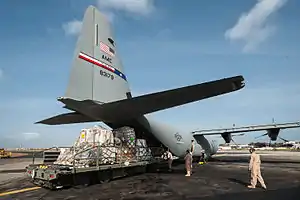787th Air Expeditionary Squadron
The 787th Air Expeditionary Squadron is a provisional United States Air Force unit, assigned to United States Air Forces Europe. The squadron has been activated twice for contingency operations in Africa.
787th Air Expeditionary Squadron
 | |
|---|---|
 Airmen and equipment deploy as the 787th Air Expeditionary Squadron for Operation United Assistance | |
| Active | 1943–1946; 1965; 2006; 2014–2015 |
| Country | |
| Branch | |
| Role | Expeditionary operations |
| Part of | United States Air Forces Europe |
| Engagements | European Theater of Operations |
| Decorations | Air Force Meritorious Unit Award |
| Insignia | |
| Patch with unofficial 787th Bombardment Squadron emblem[1][2] |  |
| World War II fuselage code[1] | 6L |
The squadron was first organized in August 1943 as the 787th Bombardment Squadron, a heavy bomber unit. After training in the United States with Consolidated B-24 Liberators, the 787th moved to England, where it participated in the strategic bombing campaign against Germany. Following V-E Day, it returned to the United States, where it began training with Boeing B-29 Superfortresses, but was inactivated in October 1945.
In 1965, the squadron was briefly active under the 33d Tactical Fighter Wing as a McDonnell F-4 Phantom II squadron, but its personnel and equipment were transferred to another unit within four months of its activation.
History
Training in the United States
The 787th Bombardment Squadron was activated at Alamogordo Army Air Field on 1 August 1943 as one of the four original squadrons of the 466th Bombardment Group. After training there with Consolidated B-24 Liberators, the squadron departed for the European Theater of Operations in February 1944.[3][4] The ground echelon proceeded to the port of embarkation for transport to Europe by ship, while the air echelon ferried their Liberators via the South Atlantic Ferry route.[5]
Combat in Europe

The squadron arrived at its combat station, RAF Attlebridge in England in March 1944. It flew its first combat mission on 22 March in an attack on Berlin, Germany. It engaged primarily in the strategic bombing campaign against Germany, with targets that included oil refineries and facilities at Bohlen and Misburg, marshalling yards at Liège and Saarbrücken, factories at Brunswick, Kempten and Eisenach, repair facilities at Reims, mining facilities near Hamburg and airfields at Saint-Trond and Chartres.[4]
The squadron also flew air support and air interdiction missions. It attacked pillboxes in Normandy on D-Day to support Operation Overlord and performed interdiction missions against targets beyond the beachhead in the following days. During Operation Cobra, the breakout at Saint Lo in July, it bombed German positions in the city. It attacked lines of communication during the Battle of the Bulge in December 1944 and January 1945. On 24 March, it supported Operation Varsity, the airborne assault across the Rhine by attacking a military air base at Nordhorn. The squadron's last mission of the war was flown on 25 April 1945 against electrical facilities at Traunstein.[4]
Return to the United States and inactivation
Following V-E Day, the squadron returned to the United States. The air echelon began flying their B-24s back to the United States in the middle of June, while the ground echelon sailed aboard the RMS Queen Mary on 6 July.[5] The squadron reassembled at Sioux Falls Army Air Field, South Dakota in late July 1945. In August, the squadron moved to Davis-Monthan Field, Arizona to begin training with the Boeing B-29 Superfortress. However with the surrender of Japan, the squadron was inactivated in October as Davis-Monthan transitioned from a training base to a storage facility.[3][4][6]
Fighter operations

As the United States Air Force expanded its McDonnell F-4 Phantom II fleet in April 1965, it activated the 33d Tactical Fighter Wing at Eglin Air Force Base Florida. Although it was planned that the squadrons of the 33d Wing would be Convair F-102 Delta Dagger squadrons that were inactivating in the Pacific, these squadrons were still winding down their operations, so the 33d was initially formed with the 786th, 787th, 788th and 789th Tactical Fighter Squadrons. The 33d embarked on a program of tactical training with the Phantom. In June 1965, the squadron was inactivated and its planes and personnel were transferred to the 16th Tactical Fighter Squadron, which moved on paper to Eglin from Misawa Air Base, Japan.[7]
Expeditionary unit
In April 2006, the squadron was converted to provisional status as the 787th Air Expeditionary Squadron and assigned to United States Air Forces Europe to activate or inactivate as needed. It deployed to Karadje, Niger in July to support Operation Eagle Vision, downloading satellite imagery for mapmaking.[8]
The squadron was activated at Dakar, Senegal, where it established a transportation hub for Operation Unified Assistance, the US military name for humanitarian operations to limit the spread of Ebola in West Africa. It relieved members of the Kentucky Air National Guard's 123d Contingency Support Group. It continued airlift missions with Lockheed C-130 Hercules aircraft for the next four months.[9][10]
Lineage
- Constituted as the 787th Bombardment Squadron (Heavy) on 19 May 1943
- Activated on 1 August 1943
- Redesignated 787th Bombardment Squadron, Heavy c. 10 August 1944
- Redesignated 787th Bombardment Squadron, Very Heavy on 5 August 1945
- Inactivated on 17 October 1945[3]
- Redesignated 787th Tactical Fighter Squadron on 9 February 1965 and activated (not organized)
- Converted to provisional status and redesignated 787th Air Expeditionary Squadron on 24 April 2006
Assignments
- 466th Bombardment Group, 1 August 1943 – 17 October 1945[3]
- Tactical Air Command, 9 February 1965 (not organized)
- 33d Tactical Fighter Wing, 1 April–20 June 1965[7]
- United States Air Forces Europe to activate or inactivate as needed after 24 April 2006
- Attached to 86th Airlift Wing, July 2006
- Attached to 435th Air Ground Operations Wing, c. 18 November 2014 – c. 13 February 2015
Stations
- Alamogordo Army Air Field, New Mexico, 1 August 1943
- Kearns Army Air Base, Utah 31 August 1943
- Alamogordo Army Air Field, New Mexico, 30 November 1943 - 10 February 1944
- RAF Attlebridge (AAF-120),[12] England 9 March 1944 - c. 6 July 1945
- Sioux Falls Army Air Field, South Dakota, 15 July 1945
- Pueblo Army Air Base, Colorado, 25 July 1945
- Davis-Monthan Field, Arizona, 15 August-17 October 1945[13]
- Eglin Air Force Base, Florida, 1 April–20 June 1965[11]
- Karadje, Niger, July 2006[8]
- Léopold Sédar Senghor International Airport, Sengal, c. 18 November 2014 – c. 13 February 2015[9][10]
Aircraft
Awards and campaigns
| Award streamer | Award | Dates | Notes |
|---|---|---|---|
| Air Force Meritorious Unit Award | 1 January 2015-31 December 2015 | 787th Air Expeditionary Squadron[14] |
| Campaign Streamer | Campaign | Dates | Notes |
|---|---|---|---|
| Air Offensive, Europe | 8 March 1944 – 5 June 1944 | 787th Bombardment Squadron[3] | |
| Air Combat, EAME Theater | 8 March 1944 – 11 May 1945 | 787th Bombardment Squadron[3] | |
| Normandy | 6 June 1944 – 24 July 1944 | 787th Bombardment Squadron[3] | |
| Northern France | 25 July 1944 – 14 September 1944 | 787th Bombardment Squadron[3] | |
| Rhineland | 15 September 1944 – 21 March 1945 | 787th Bombardment Squadron[3] | |
| Ardennes-Alsace | 16 December 1944 – 25 January 1945 | 787th Bombardment Squadron[3] | |
| Central Europe | 22 March 1944 – 21 May 1945 | 787th Bombardment Squadron[3] |
See also
References
- Notes
- The aircraft in the photograph is clearly a 466th Group airplane, based on its markings. It is identified in the photograph as Consolidated B-24J-180-CO Liberator, serial 44-40807. However, the aircraft's serial number is not clear in the photograph, and Baugher identifies the aircraft with this serial number as assigned to the 758th Bombardment Squadron, a unit in the Mediterranean Theater of Operations. Baugher, Joe (10 June 2023). "1944 USAF Serial Numbers". Joe Baugher. Retrieved 18 July 2023.
- Notes
- Watkins, pp. 105-106
- See Maurer, Combat Squadrons, p. 756 (no official emblem)
- Maurer, Combat Squadrons, pp. 755-756
- Maurer, Combat Units, pp. 341-342
- Freeman, p. 259
- Mueller, p. 99
- Bailey, Carl E. (28 November 2007). "Factsheet 33 Fighter Wing (ACC)". Air Force Historical Research Agency. Retrieved 13 February 2017.
- Dorrance, Capt Erin (26 August 2011). "Ramstein Airmen assist villagers in Niger". European Command Public Affairs. Retrieved 15 February 2017.
- Greer, Maj Dale (18 November 2014). "Kentucky Air Guard completes Ebola-response mission in Senegal". Joint Task Force Senegal Public Affairs. Retrieved 15 February 2017.
- Taunton, Capt Sybil (13 February 2015). "AF Ebola support winds down". European Command Public Affairs. Retrieved 15 February 2017.
- See Bailey, Factsheet 33 Fighter Wing
- Station number in Anderson.
- Station information through 1963 in Maurer, Combat Squadrons, pp. 755-756, except as noted.
- "Air Force Personnel Services: Unit Awards". Air Force Personnel Center. Retrieved 18 July 2019. (search)
Bibliography
![]() This article incorporates public domain material from the Air Force Historical Research Agency.
This article incorporates public domain material from the Air Force Historical Research Agency.
- Anderson, Capt. Barry (1985). Army Air Forces Stations: A Guide to the Stations Where U.S. Army Air Forces Personnel Served in the United Kingdom During World War II (PDF). Maxwell AFB, AL: Research Division, USAF Historical Research Center. Archived from the original (PDF) on 23 January 2016. Retrieved 7 July 2012.
- Maurer, Maurer, ed. (1983) [1961]. Air Force Combat Units of World War II (PDF) (reprint ed.). Washington, DC: Office of Air Force History. ISBN 0-912799-02-1. LCCN 61060979. Retrieved 17 December 2016.
- Maurer, Maurer, ed. (1982) [1969]. Combat Squadrons of the Air Force, World War II (PDF) (reprint ed.). Washington, DC: Office of Air Force History. ISBN 0-405-12194-6. LCCN 70605402. OCLC 72556. Retrieved 17 December 2016.
- Ravenstein, Charles A. (1984). Air Force Combat Wings, Lineage & Honors Histories 1947-1977. Washington, DC: Office of Air Force History. ISBN 0-912799-12-9. Retrieved 17 December 2016.
- Watkins, Robert (2008). Battle Colors: Insignia and Markings of the Eighth Air Force In World War II. Vol. I (VIII) Bomber Command. Atglen, PA: Shiffer Publishing Ltd. ISBN 978-0-7643-1987-7.



